整体架构篇
# 定义路由
# 安装
现在界面光秃秃的不好看,而且只有一页,我们先安装一下react router,老规矩,这是react router的文档 (opens new window),一定要多看文档,一定要多看文档,一定要多看文档,重要的事情说三遍。
npm install react-router-dom -S
# 定义路由
react router有两种路由,一种是HashRouter,另一种是BrowserRouter,其中HashRouter并不需要服务端做配置,而是路由中带一个#键,由前端来转发,所以我们选用HashRouter
- 在App.tsx中引入HashRouter,并让HashRouter包裹在最外层
// app.tsx
import { HashRouter } from "react-router-dom"
const App = () => {
return (
<HashRouter>
App
</HashRouter>
)
}
export default App
2
3
4
5
6
7
8
9
10
11
12
新建views文件夹,定义login.tsx和home.tsx两个页面

新建routers文件夹,里面定义路由相关的东西,首先创建 index.tsx,我们使用
useRoute钩子
import {useRoutes} from "react-router-dom"
import Login from "@/views/login/index"
import Home from "@/views/home/index"
export const rootRouter = [
{
path:"/",
element: <Home></Home>
},
{
path:'/login',
element: <Login></Login>
}
]
const Router = () => {
const routes = useRoutes(rootRouter)
return routes
}
export default Router
2
3
4
5
6
7
8
9
10
11
12
13
14
15
16
17
18
19
20
21
22
23
- 在App.tsx中引入Router
import { HashRouter } from "react-router-dom"
import Router from "@/routers/index"
const App = () => {
return (
<HashRouter>
<Router />
</HashRouter>
)
}
export default App
2
3
4
5
6
7
8
9
10
11
12
访问地址http://localhost:5000/,页面渲染出刚刚定义的home.tsx的内容
访问地址http://localhost:5000/#/login,页面渲染出刚刚定义的login.tsx的内容
# 安装antd
因为后面会用到antd中的一些组件,所以安装antd,antd官网 (opens new window)
npm install antd -S
然后在main.tsx中引入样式文件
import "antd/dist/reset.css"
后面需要使用antd组件的时候再按需加载即可
# 路由懒加载
随着页面越来越多,一次性加载所有页面资源非常的占用时间,有没有一种办法,可以只加载当然要访问的那个页面呢?
在react官方文档上其实给出了解决方案,React.Lazy (opens new window)
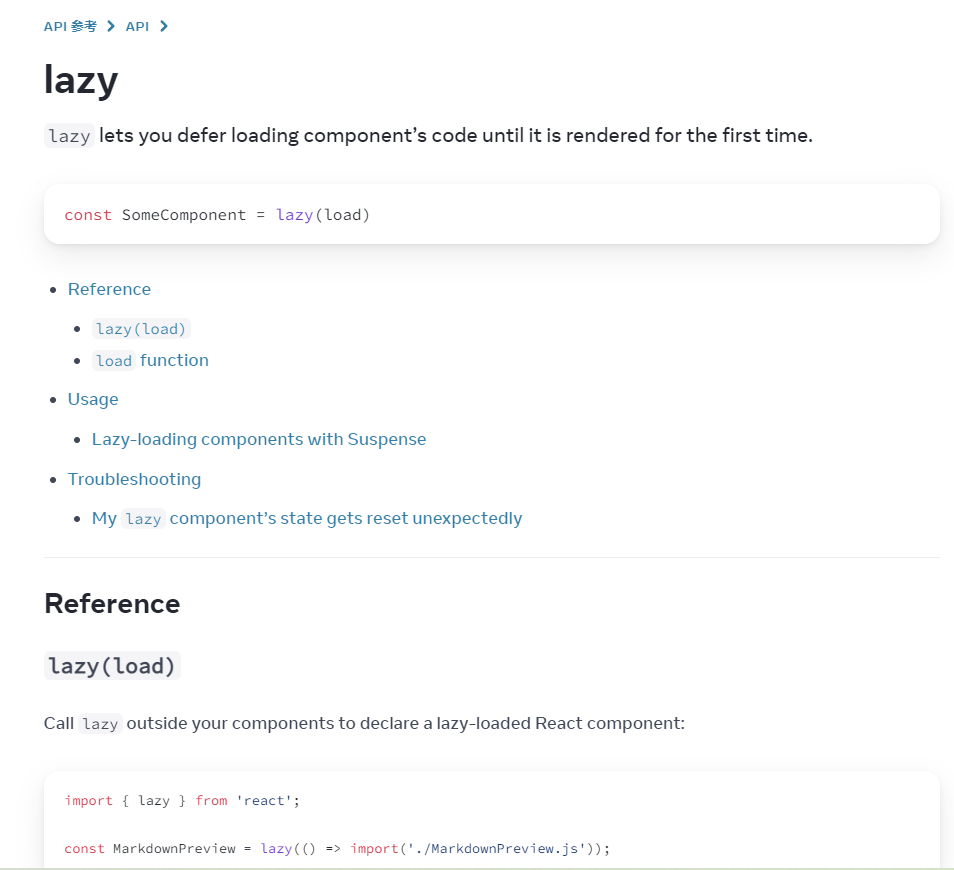 但是懒加载会花上一段时间,在这段时间内会有白屏的现象,可以将懒加载的组件用
但是懒加载会花上一段时间,在这段时间内会有白屏的现象,可以将懒加载的组件用Suspense标签包裹起来,Suspense的fallback属性是组件没有加载出来时显示的内容。
- 在routers下新建 utils/lazyLoad.tsx
- lazyLoad接收React.lazy()加载的组件,加载过程中显示antd的Spin组件
import React, { Suspense } from 'react';
import { Spin } from 'antd';
/**
* @description 路由懒加载
* @param 需要访问的组件
* @returns
*/
const lazyLoad = (Comp:React.LazyExoticComponent<() => JSX.Element>) => {
return (
<>
<Suspense fallback={
<Spin
size="large"
style={{
display: "flex",
alignItems: "center",
justifyContent: "center",
height: "100%"
}}
/>
}>
<Comp />
</Suspense>
</>
);
}
export default lazyLoad
2
3
4
5
6
7
8
9
10
11
12
13
14
15
16
17
18
19
20
21
22
23
24
25
26
27
28
29
- 在router/index.tsx中将路由中加载的组件改写为懒加载方式
import {useRoutes} from "react-router-dom"
import lazyLoad from "./utils/lazyLoad"
import React from "react"
export const rootRouter = [
{
path:"/",
element: lazyLoad(React.lazy(() => import("@/views/home")))
},
{
path:'/login',
element: lazyLoad(React.lazy(() => import("@/views/login")))
}
]
const Router = () => {
const routes = useRoutes(rootRouter)
return routes
}
export default Router
2
3
4
5
6
7
8
9
10
11
12
13
14
15
16
17
18
19
20
21
22
切换页面地址,可以看到对应组件被加载了
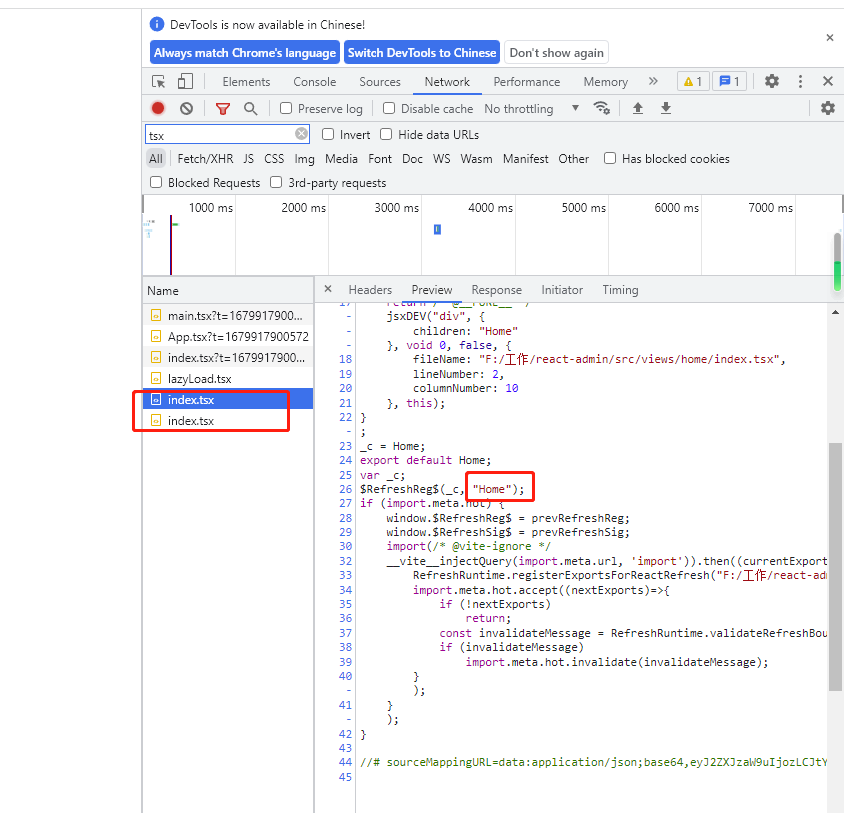
# 登录界面
登录界面比较简陋,简单用antd的Form组件写个登录界面
// login.tsx
import LoginForm from "./components/loginForm"
import logo from "@/assets/images/react.svg"
import "./index.less"
const Login = () => {
return (
<div className="login-container">
<div className="login-box">
<div className="login-form">
<div className="login-logo">
<img className="login-icon" src={logo} alt="logo" />
<span className="logo-text">My-React-Admin</span>
</div>
<LoginForm />
</div>
</div>
</div>
)
}
export default Login
2
3
4
5
6
7
8
9
10
11
12
13
14
15
16
17
18
19
20
21
22
定义一下登录界面的ts类型, 登录界面表单一共有两个字段,username和passord,它们都是string类型:
// types/login.ts
// * 登录
export namespace Login {
export interface ReqLoginForm {
username: string;
password: string;
}
}
2
3
4
5
6
7
8
// login/components/loginForm.tsx
import {Button, Form, Input} from "antd"
import { UserOutlined, LockOutlined, CloseCircleOutlined } from "@ant-design/icons";
import { useState } from "react";
import { Login } from "@/types/login";
const LoginForm = () => {
const [loading, setLoading] = useState<boolean>(false)
const [form] = Form.useForm()
//login
const onFinish = async (loginForm: Login.ReqLoginForm) => {
console.log(loginForm)
}
const onFinishFailed = (errorInfo: any) => {
console.log("Failed", errorInfo)
}
return (
<Form
form={form}
name="basic"
labelCol={{span:5}}
initialValues={{remenber: true}}
size="large"
onFinish={onFinish}
onFinishFailed={onFinishFailed}
autoComplete="off"
>
<Form.Item name="username" rules={[{required:true, message:"请输入用户名"}]}>
<Input placeholder="用户名:admin/user" prefix={<UserOutlined />}/>
</Form.Item>
<Form.Item name="password" rules={[{required:true, message:'请输入密码'}]}>
<Input.Password autoComplete="new-password" placeholder="密码:123456" prefix={<LockOutlined />}/>
</Form.Item>
<Form.Item className="login-btn">
<Button
onClick={() => {
form.resetFields()
}}
icon={<CloseCircleOutlined />}
>
重置
</Button>
<Button type="primary" loading={loading} htmlType="submit" icon={<UserOutlined />}>登录</Button>
</Form.Item>
</Form>
)
}
export default LoginForm
2
3
4
5
6
7
8
9
10
11
12
13
14
15
16
17
18
19
20
21
22
23
24
25
26
27
28
29
30
31
32
33
34
35
36
37
38
39
40
41
42
43
44
45
46
47
48
49
50
51
52
登录界面现在的样子如下:
 输入用户名和密码点击登录,控制台会打印出刚刚的输入:
输入用户名和密码点击登录,控制台会打印出刚刚的输入:
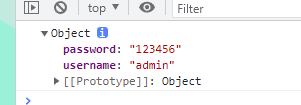
# 使用easy mock模拟登录接口
使用easy mock来造一个简单的登录接口,Easy Mock (opens new window),可以去看一下基本的使用方法,还是很简单的。 创建post方式的登录接口如下,其实就是自己写个假的
{
code: function({
_req,
Mock
}) {
if ((_req.body.username == 'admin' || _req.body.username == 'user') && _req.body.password == 'e10adc3949ba59abbe56e057f20f883e') {
return 200
} else {
return 500
}
},
msg: function({
_req,
Mock
}) {
if ((_req.body.username == 'admin' || _req.body.username == 'user') && _req.body.password == 'e10adc3949ba59abbe56e057f20f883e') {
return '登录成功'
} else {
return '密码错误'
}
},
data: function({
_req,
Mock
}) {
if (_req.body.username == 'admin' && _req.body.password == 'e10adc3949ba59abbe56e057f20f883e') {
return {
access_token: "bqddxxwqmfncffacvbpkuxvwvqrhln"
}
} else if (_req.body.username == 'user' && _req.body.password == 'e10adc3949ba59abbe56e057f20f883e') {
return {
access_token: "unufvdotdqxuzfbdygovfmsbftlvbn"
}
} else {
return null
}
}
}
2
3
4
5
6
7
8
9
10
11
12
13
14
15
16
17
18
19
20
21
22
23
24
25
26
27
28
29
30
31
32
33
34
35
36
37
38
# 使用redux
Redux (opens new window)是应用的状态管理容器,对标vue的vuex,redux官方推荐使用redux toolkit,先安装一下:
npm install @reduxjs/toolkit react-redux -S
# store设计
redux toolkit 可以使用 createSlice 来创建store的切片,然后通过combineReducers再将它们组装起来。 先创建一个切片专门存放token和用户信息。
// redux/modules/global.ts
import { GlobalState } from "@/types/redux";
import { createSlice } from "@reduxjs/toolkit"
const globalState: GlobalState = {
token:"",
userInfo:{
username:""
}
}
const globalSlice = createSlice({
name: "global",
initialState: globalState,
reducers: {
setToken(state: GlobalState, {payload}) {
state.token = payload
},
setUserInfo(state: GlobalState, {payload}) {
state.userInfo = payload
}
}
})
export const {setToken, setUserInfo} = globalSlice.actions
export default globalSlice.reducer
2
3
4
5
6
7
8
9
10
11
12
13
14
15
16
17
18
19
20
21
22
23
24
25
26
在types/redux.ts中定义一下GlobalState的类型:
export interface UserInfo {
username:string;
}
/* GlobalState */
export interface GlobalState {
token:string;
userInfo:UserInfo;
}
/* State */
export interface State {
global: GlobalState
}
2
3
4
5
6
7
8
9
10
11
12
13
14
然后在redux/index.ts中创建store:
import { configureStore } from "@reduxjs/toolkit";
import global from "./modules/global";
import { combineReducers } from "@reduxjs/toolkit";
// combineReducers合并reducer
const reducers = combineReducers({
global
})
export const store = configureStore({
reducer: reducers
})
2
3
4
5
6
7
8
9
10
11
12
store创建完,需要在main.ts中使用Provider来包裹住需要使用store的组件:
import React from 'react'
import ReactDOM from 'react-dom/client'
import App from '@/App'
import "@/styles/reset.less"
import "antd/dist/reset.css"
import { Provider } from 'react-redux'
import { store } from "@/redux"
ReactDOM.createRoot(document.getElementById('root') as HTMLElement).render(
<Provider store={store}>
<App />
</Provider>
)
2
3
4
5
6
7
8
9
10
11
12
13
14
# redux-persist持久化
redux-persist 主要用于帮助我们实现redux的状态持久化 所谓状态持久化就是将状态与本地存储联系起来,达到刷新或者关闭重新打开后依然能得到保存的状态。 先安装redux-persist,这个插件配合redux-toolkit使用时,需要redux-thunk
npm install redux-persist redux-thunk -S
安装完毕后改造一下redux/index.ts,创建persistedReducer,并且使用reduxThunk
import { configureStore } from "@reduxjs/toolkit";
import global from "./modules/global";
import { combineReducers } from "@reduxjs/toolkit";
import storage from "redux-persist/lib/storage";
import { persistReducer, persistStore } from "redux-persist"; //数据持久化
import reduxThunk from "redux-thunk"
// combineReducers合并reducer
const reducers = combineReducers({
global
})
const presistConfig = {
key:'react-admin',
storage
}
const persistedReducer = persistReducer(presistConfig, reducers)
export const store = configureStore({
reducer: persistedReducer,
middleware: [reduxThunk]
})
export const persistor = persistStore(store)
2
3
4
5
6
7
8
9
10
11
12
13
14
15
16
17
18
19
20
21
22
23
24
25
在main.tsx中使用PersistGate标签包裹App组件:
import React from 'react'
import ReactDOM from 'react-dom/client'
import App from '@/App'
import "@/styles/reset.less"
import "antd/dist/reset.css"
import { Provider } from 'react-redux'
import { store, persistor } from "@/redux"
import { PersistGate } from 'redux-persist/integration/react'
ReactDOM.createRoot(document.getElementById('root') as HTMLElement).render(
<Provider store={store}>
<PersistGate persistor={persistor}>
<App />
</PersistGate>
</Provider>
)
2
3
4
5
6
7
8
9
10
11
12
13
14
15
16
# 测试redux
在home.tsx中,简单写点代码测试一下store,点击按钮修改token:
import { useDispatch, useSelector } from "react-redux"
import { setToken } from "@/redux/modules/global"
import { State } from "@/types/redux"
const Home = () => {
const dispatch = useDispatch()
const {token} = useSelector((state:State) => state.global)
const handleClick = () => {
dispatch(setToken('123456789'))
}
return (
<div>
{token}
<button onClick={handleClick}>修改token</button>
</div>
)
}
export default Home
2
3
4
5
6
7
8
9
10
11
12
13
14
15
16
17
18
19
20
21
使用useSelector钩子来获取state.global中的token。
setToken是global.ts中导出的修改token的reducers方法,传入dispath方法中来修改token。
点击按钮后,token成功变为123456789。
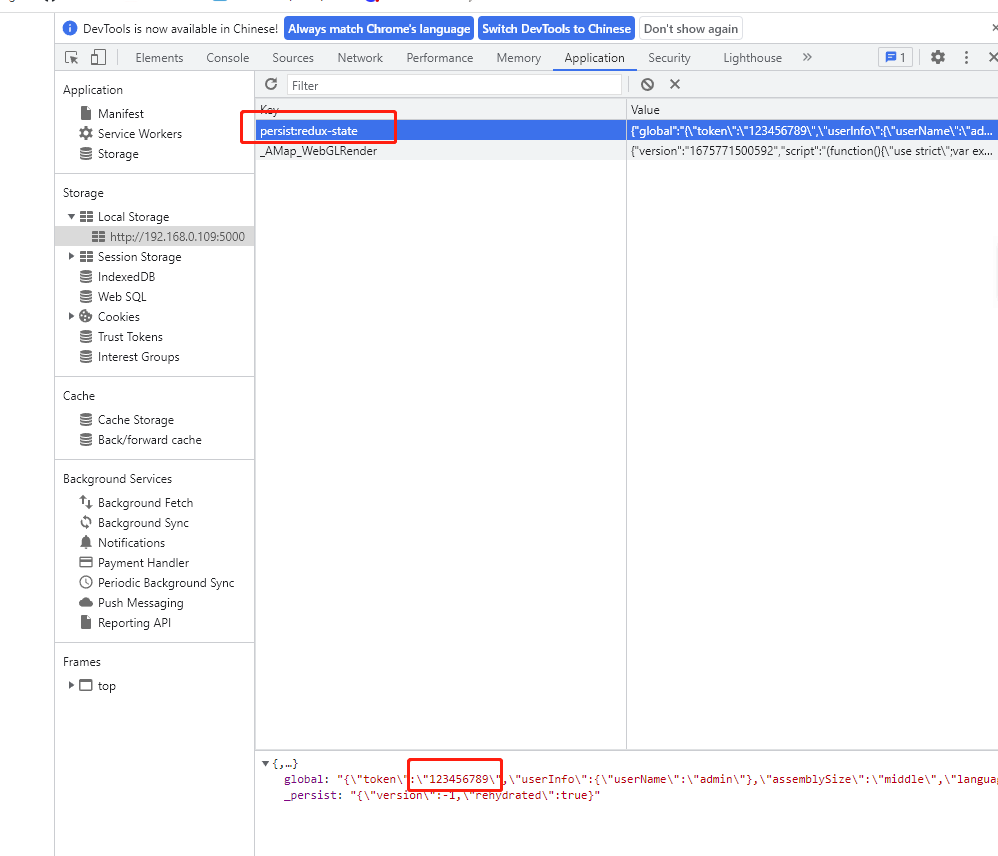
在控制台中可以看到数据持久化也是成功的。
# 封装axios
先安装axios和nprogress
npm install axios nprogress qs -S
npm install @types/nprogress @types/qs -D
2
# 定义枚举
// enum/httpEnum.ts
// * 请求枚举配置
/**
* @description: 请求配置
*/
export enum ResultEnum {
SUCCESS = 200,
ERROR = 500,
OVERDUE = 599,
TIMEOUT = 10000,
TYPE = "success"
}
2
3
4
5
6
7
8
9
10
11
12
# 定义判断类型的工具函数
// utils/is.ts
const toString = Object.prototype.toString
/**
* @description: 判断值是否为某个类型
*/
export function is(val: unknown, type: string) {
return toString.call(val) === `[object ${type}]`
}
/**
* @description: 是否为函数
*/
export function isFunction<T = Function>(val: unknown): val is T {
return is(val, "Function")
}
2
3
4
5
6
7
8
9
10
11
12
13
14
15
16
# 定义response返回类型
// types/api.ts
// * 请求响应参数(不包含data)
export interface Result {
code: string;
msg: string;
}
// * 请求响应参数(包含data)
export interface ResultData<T = any> extends Result {
data?:T;
}
2
3
4
5
6
7
8
9
10
11
# 配置nprogress
// api/helper/nprogress.ts
import NProgress from "nprogress"
import "nprogress/nprogress.css"
NProgress.configure({
easing: "ease", //动画方式
speed: 500, // 递增进度条的速度
showSpinner: true, // 是否显示加载ico
trickleSpeed: 200, // 自动递增间隔
minimum: 0.3 //初始化时的最小百分比
})
export default NProgress
2
3
4
5
6
7
8
9
10
11
12
13
# 封装错误状态判断方法
// api/helper/checkStatus.ts
import {message} from "antd"
/**
* @description: 校验网络请求状态码
* @param {Number} status
* @return void
*/
export const checkStatus = (status: number): void => {
switch (status) {
case 400:
message.error("请求失败!请您稍后重试");
break;
case 401:
message.error("登录失效!请您重新登录");
break;
case 403:
message.error("当前账号无权限访问!");
break;
case 404:
message.error("你所访问的资源不存在!");
break;
case 405:
message.error("请求方式错误!请您稍后重试");
break;
case 408:
message.error("请求超时!请您稍后重试");
break;
case 500:
message.error("服务异常!");
break;
case 502:
message.error("网关错误!");
break;
case 503:
message.error("服务不可用!");
break;
case 504:
message.error("网关超时!");
break;
default:
message.error("请求失败!");
}
};
2
3
4
5
6
7
8
9
10
11
12
13
14
15
16
17
18
19
20
21
22
23
24
25
26
27
28
29
30
31
32
33
34
35
36
37
38
39
40
41
42
43
44
# 封装取消请求方法
// api/helper/axiosCancel.ts
import axios, {AxiosRequestConfig, Canceler} from "axios"
import {isFunction} from "@/utils/is"
import qs from "qs"
// * 声明一个Map用于存储每个请求的标识和取消函数
let pendingMap = new Map<string, Canceler>()
// * 序列化参数
export const getPendingUrl = (config: AxiosRequestConfig) =>
[config.method,config.url,qs.stringify(config.data), qs.stringify(config.params)].join("&")
export class AxiosCanceler {
/**
* @description: 添加请求
* @param {Object} config
*/
addPending(config: AxiosRequestConfig) {
// * 在请求开始前,对之前的请求做检查取消操作
this.removePending(config)
const url = getPendingUrl(config)
config.cancelToken =
config.cancelToken || new axios.CancelToken(cancel => {
if(!pendingMap.has(url)) {
// 如果pending中不存在当前请求,则添加进去
pendingMap.set(url, cancel)
}
})
}
/**
* @description: 移除请求
* @param {Object} config
*/
removePending(config: AxiosRequestConfig) {
const url = getPendingUrl(config)
if(pendingMap.has(url)) {
//如果在pending中存在当前请求标识,需要取消当前请求,并且移除
const cancel = pendingMap.get(url)
cancel && cancel()
pendingMap.delete(url)
}
}
/**
* @description: 清空所有pending
*/
removeAllPending() {
pendingMap.forEach(cancel => {
cancel && isFunction(cancel) && cancel()
})
pendingMap.clear()
}
/**
* @description: 重置
*/
reset():void {
pendingMap = new Map<string, Canceler>()
}
}
2
3
4
5
6
7
8
9
10
11
12
13
14
15
16
17
18
19
20
21
22
23
24
25
26
27
28
29
30
31
32
33
34
35
36
37
38
39
40
41
42
43
44
45
46
47
48
49
50
51
52
53
54
55
56
57
58
59
60
61
62
# 封装axios
import NProgress from "./helper/nprogress";
import axios, {AxiosInstance, AxiosRequestConfig, AxiosError} from "axios"
import { store } from "@/redux"
import { setToken } from "@/redux/modules/global"
import { ResultEnum } from "@/enums/httpEnum"
import { message } from "antd"
import { checkStatus } from "./helper/checkStatus"
import { ResultData } from "@/types/api"
import { AxiosCanceler } from "./helper/axiosCancel"
const axiosCanceler = new AxiosCanceler()
const config = {
//默认地址请求地址,可在.env开头文件中修改
baseURL: import.meta.env.VITE_API_URL as string,
// 设置超时时间(10s)
timeout: ResultEnum.TIMEOUT as number,
// 跨域时允许携带凭证
widthCredentials: true
}
class RequestHttp {
service: AxiosInstance;
constructor(config: AxiosRequestConfig) {
// 实例化axios
this.service = axios.create(config)
/**
* @description 请求拦截器
* 客户端发送请求 -> [请求拦截器] -> 服务器
* token校验(JWT): 接受服务器返回的token,存储到redux/本地存储当中
*/
this.service.interceptors.request.use(
(config) => {
NProgress.start()
// * 将当前请求添加到 pending 中
axiosCanceler.addPending(config)
const token:string = store.getState().global.token
config.headers["x-access-token"] = token
return config
},
(error: AxiosError) => {
return Promise.reject(error)
}
)
/**
* @description 响应拦截器
* 服务器返回信息 -> [拦截统一处理] -> 客户端JS获取到信息
*/
this.service.interceptors.response.use(
(response) => {
const {data, config} = response
NProgress.done()
// * 在请求结束后,移除本次请求(关闭loading)
axiosCanceler.removePending(config)
// * 登录失败(code == 599)
if (data.code == ResultEnum.OVERDUE) {
store.dispatch(setToken(""))
message.error(data.msg)
window.location.hash = "/login"
return Promise.reject(data)
}
// * 全局错误信息拦截(防止下载文件的时候返回数据流,没有code,直接报错)
if(data.code && data.code !== ResultEnum.SUCCESS) {
message.error(data.msg)
return Promise.reject(data)
}
// * 请求成功(在页面上除非特殊情况,否则不用处理失败逻辑)
return data;
},
(error: AxiosError) => {
const {response} = error
NProgress.done()
// 请求超时单独判断,请求超时没有response
if(error.message.indexOf("timeout") !== -1) {
message.error("请求超时,请稍后再试")
}
// 根据响应的错误状态码, 做不同的处理
if(response) {
checkStatus(response.status)
}
// 服务器结果都没有返回(可能服务器错误可能客户端断网) 断网处理:可以跳转到断网页面
if(!window.navigator.onLine) {
window.location.hash = "/500"
}
return Promise.reject(error)
}
)
}
// * 常用请求方法封装
get<T>(url:string,params?:object,_object = {}): Promise<ResultData<T>> {
return this.service.get(url, {...params, ..._object})
}
post<T>(url:string,params?:object,_object = {}): Promise<ResultData<T>> {
return this.service.post(url, {...params, ..._object})
}
put<T>(url:string,params?:object,_object = {}): Promise<ResultData<T>> {
return this.service.put(url, {...params, ..._object})
}
delete<T>(url:string,params?:object,_object = {}): Promise<ResultData<T>> {
return this.service.delete(url, {...params, ..._object})
}
}
export default new RequestHttp(config)
2
3
4
5
6
7
8
9
10
11
12
13
14
15
16
17
18
19
20
21
22
23
24
25
26
27
28
29
30
31
32
33
34
35
36
37
38
39
40
41
42
43
44
45
46
47
48
49
50
51
52
53
54
55
56
57
58
59
60
61
62
63
64
65
66
67
68
69
70
71
72
73
74
75
76
77
78
79
80
81
82
83
84
85
86
87
88
89
90
91
92
93
94
95
96
97
98
99
100
101
102
103
104
105
106
107
# 封装全局Loading
封装一个全局的Loading条,首先封装一下组件
// components/Loading/index
import {Spin} from "antd"
import "./index.less"
const Loading = ({tip = "Loading"}: {tip?: string}) => {
return <Spin tip={tip} size="large" className="request-loading"></Spin>
}
export default Loading
2
3
4
5
6
7
8
9
然后定义一下显示和隐藏loading的方法
// api/helper/serviceLoading.tsx
import ReactDOM from "react-dom/client"
import Loading from "@/components/Loading/index"
let needLoadingRequestCount = 0
// * 显示loading
export const showFullScreenLoading = () => {
if(needLoadingRequestCount === 0) {
let dom = document.createElement("div")
dom.setAttribute("id", "loading")
document.body.appendChild(dom)
ReactDOM.createRoot(dom).render(<Loading />)
}
needLoadingRequestCount++
}
// * 隐藏loading
export const tryHideFullScreenLoading = () => {
if(needLoadingRequestCount <= 0) return
needLoadingRequestCount--
if(needLoadingRequestCount == 0) {
document.body.removeChild(document.getElementById("loading") as HTMLElement)
}
}
2
3
4
5
6
7
8
9
10
11
12
13
14
15
16
17
18
19
20
21
22
23
24
25
然后在封装的RequestHttp类中使用:
//...
import { showFullScreenLoading, tryHideFullScreenLoading } from "./helper/serviceLoading"
//...
const axiosCanceler = new AxiosCanceler()
//...
class RequestHttp {
service: AxiosInstance;
constructor(config: AxiosRequestConfig) {
//...
this.service.interceptors.request.use(
(config) => {
//...
config?.headers!.noLoading || showFullScreenLoading()
//...
},
//...
)
/**
* @description 响应拦截器
* 服务器返回信息 -> [拦截统一处理] -> 客户端JS获取到信息
*/
this.service.interceptors.response.use(
(response) => {
//...
tryHideFullScreenLoading()
//...
},
(error: AxiosError) => {
//...
tryHideFullScreenLoading()
//...
}
)
}
//...
}
export default new RequestHttp(config)
2
3
4
5
6
7
8
9
10
11
12
13
14
15
16
17
18
19
20
21
22
23
24
25
26
27
28
29
30
31
32
33
34
35
36
37
38
39
40
41
刚刚新增的文件比较多,现在项目的目录结构如下:

# 对接登录
做了这么多,终于可以对接之前的登录接口了,需要做以下几件事
- 封装登录api
新建/api/modules/login.ts,调用刚刚封装好的HttpRequest类中的post方法:
import {Login} from "@/types/login"
import http from "@/api"
/**
* @name 登录模块
*/
// 用户登录接口
export const loginApi = (params: Login.ReqLoginForm) => {
return http.post<Login.ResLogin>(`/login`, params)
}
2
3
4
5
6
7
8
9
10
补全一下Login命名空间下登录接口返回的类型
// * 登录
export namespace Login {
export interface ReqLoginForm {
username: string;
password: string;
}
export interface ResLogin {
access_token: string;
}
}
2
3
4
5
6
7
8
9
10
11
- 在登录页面调用
- 登录完保存用户信息以及token 登录接口上传的密码用md5加过密,因此安装一下 js-md5
npm install js-md5 -S
npm install @types/js-md5 -D
2
然后在 views/login/components/loginForm.tsx中调用
import {Button, Form, Input} from "antd"
import { UserOutlined, LockOutlined, CloseCircleOutlined } from "@ant-design/icons";
import { useState } from "react";
import { Login } from "@/types/login";
import { useDispatch } from "react-redux";
import { useNavigate } from "react-router-dom";
import md5 from "js-md5"
import { loginApi } from "@/api/modules/login";
import { setToken, setUserInfo } from "@/redux/modules/global";
// HOME_URL就是'/',我们在编写代码的时候要尽量少写重复的字符串
import { HOME_URL } from "@/utils/config";
const LoginForm = () => {
const dispatch = useDispatch()
const navigate = useNavigate()
const [loading, setLoading] = useState<boolean>(false)
const [form] = Form.useForm()
//login
const onFinish = async (loginForm: Login.ReqLoginForm) => {
try { // 使用try catch来捕获代码块里所有的抛出异常
// 将登录按钮的Loading改为true
setLoading(true)
// 密码使用md5加密
loginForm.password = md5(loginForm.password)
// 调用登录Api
const {data} = await loginApi(loginForm)
// token存入store
dispatch(setToken(data?.access_token))
// 存入userInfo
dispatch(setUserInfo({userName: loginForm.username}))
// 跳转到home主页
navigate(HOME_URL)
} catch(e) {
console.log(e)
} finally {
// Loading置为false
setLoading(false)
}
}
//...后面的省略
2
3
4
5
6
7
8
9
10
11
12
13
14
15
16
17
18
19
20
21
22
23
24
25
26
27
28
29
30
31
32
33
34
35
36
37
38
39
40
41
42
43
登录成功后看一下token和用户信息已经保存成功了。

# 导航守卫
刚刚登录成功保存了token,新的需求就来了,在我们没有token的时候应该是禁止访问主页的,应该直接跳转回登录界面。
新建 routers/utils/authRouter.tsx,AuthRouter组件包裹在Router外,当token和pathname发生变化时,判断有没有token,如果没有就跳转到登录页面。
// routers/utils/authRouter.tsx
import {useLocation,useNavigate} from "react-router-dom"
import { useSelector } from "react-redux"
import { useEffect } from "react"
import { State } from "@/types/redux"
const AuthRouter = (props:any) => {
const { token } = useSelector((state:State) => state.global)
const { pathname } = useLocation()
const navigate = useNavigate()
useEffect(() => {
!token && navigate('/login')
},[token, pathname])
return props.children
}
export default AuthRouter
2
3
4
5
6
7
8
9
10
11
12
13
14
15
16
17
18
19
20
// App.tsx
import { HashRouter } from "react-router-dom"
import Router from "@/routers/index"
import AuthRouter from "./routers/utils/authRouter"
const App = () => {
return (
<HashRouter>
<AuthRouter>
<Router />
</AuthRouter>
</HashRouter>
)
}
export default App
2
3
4
5
6
7
8
9
10
11
12
13
14
15
16
17
# Layout
我们要做的后台管理系统,除了登录界面,几乎所有的其他界面布局都类似,拥有一个头部信息栏,以及左侧导航栏,这部分布局没必要重复写多次,因此我们可以写一个通用的布局
# Layout布局
Layout主要由侧边菜单,头部,中间内页部分,页脚组成,每个组件我们先简单写点东西占位
// layouts/index.tsx
import { Layout } from "antd"
import { Outlet } from "react-router-dom"
import LayoutMenu from "./components/Menu"
import LayoutHeader from "./components/Header"
import LayoutFooter from "./components/Footer"
import "./index.less"
const LayoutIndex = () => {
const {Sider, Content} = Layout
return (
<section className="container">
<Sider trigger={null} collapsed={false} width={220} theme="dark">
<LayoutMenu></LayoutMenu>
</Sider>
<Layout>
<LayoutHeader></LayoutHeader>
<Content>
<div className="content">
<Outlet />
</div>
</Content>
<LayoutFooter />
</Layout>
</section>
)
}
export default LayoutIndex
2
3
4
5
6
7
8
9
10
11
12
13
14
15
16
17
18
19
20
21
22
23
24
25
26
27
28
29
30
# 关于二级路由以及Outlet
将home改造成二级路由并且单独抽出,以后方便渲染侧边栏。
// router/routerList.tsx
import Layout from "@/layouts/index"
import Home from "@/views/home"
export const routerList = [
{
element: <Layout />,
children: [
{
path:"/",
element: <Home />,
meta: {
reqiureAuth: true,
title: "首页",
key: "home",
icon:'HomeOutlined'
}
}
]
}
]
2
3
4
5
6
7
8
9
10
11
12
13
14
15
16
17
18
19
20
21
// routers/index.tsx
import {useRoutes} from "react-router-dom"
import lazyLoad from "./utils/lazyLoad"
import React from "react"
import { routerList } from "./routerList"
export const rootRouter = [
{
path:'/login',
element: lazyLoad(React.lazy(() => import("@/views/login")))
},
...routerList
]
const Router = () => {
const routes = useRoutes(rootRouter)
return routes
}
export default Router
2
3
4
5
6
7
8
9
10
11
12
13
14
15
16
17
18
19
20
21
在父路由中的Outlet组件可以用来加载子路由,再次进入首页,现在首页的效果如下:
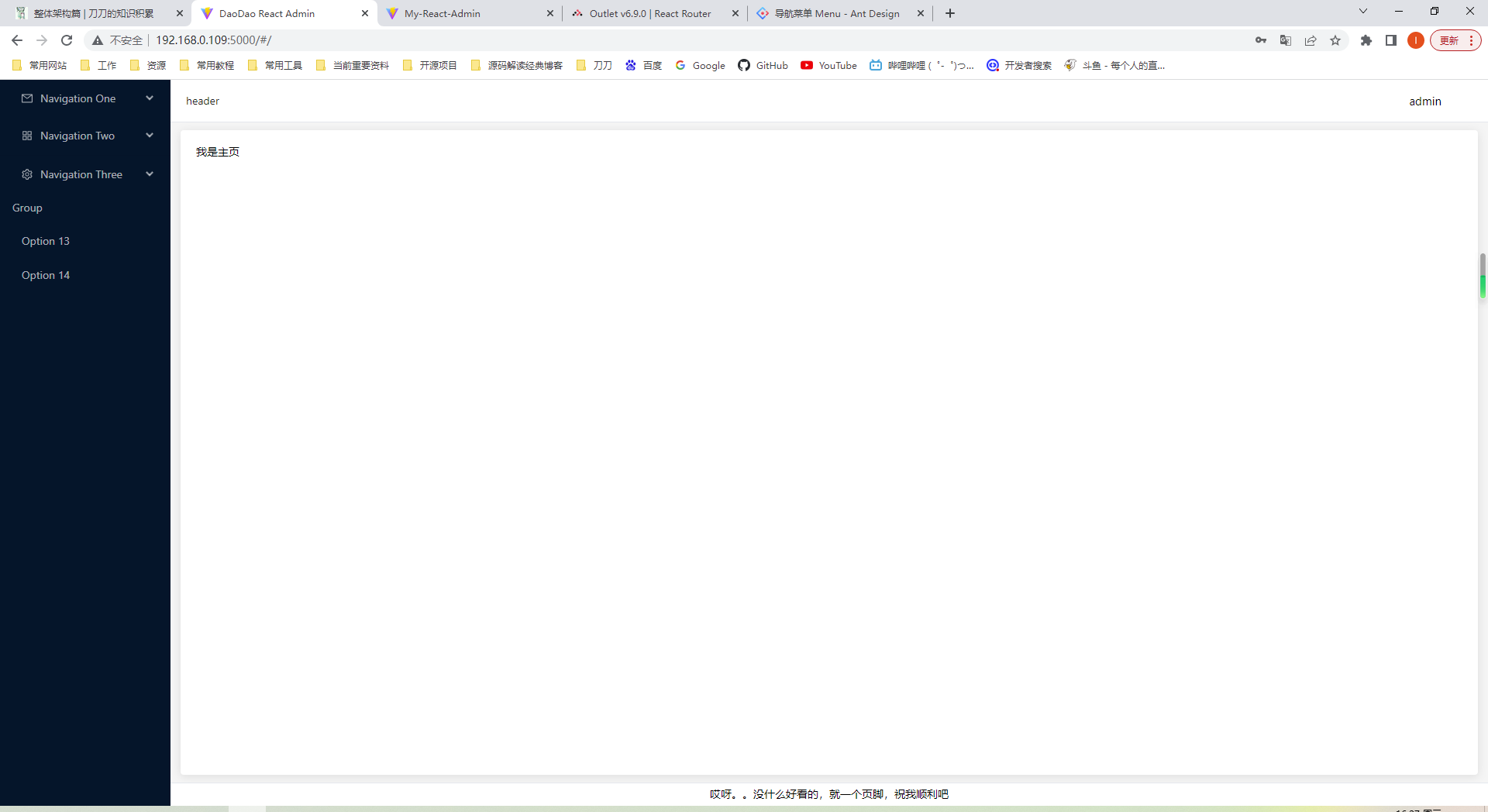
# 侧边栏
现在的侧边栏是我复制的antd官方的例子,实际上我是想让侧边栏显示出路由配置的页面。因此我们随意新增几条路由,这是一个三层嵌套的路由
// routers/routerList.tsx
import Layout from "@/layouts/index"
import Home from "@/views/home"
export const routerList = [
{
element: <Layout />,
children: [
{
path:"/",
element: <Home />,
meta: {
reqiureAuth: true,
title: "首页",
key: "home",
icon:'HomeOutlined'
}
}
]
},
{
element: <Layout />,
path:'/test',
meta: {
title:"测试菜单",
icon:'DatabaseOutlined'
},
children: [
{
path:"/test/test1",
element: <div>测试1</div>,
meta: {
reqiureAuth: true,
title: "测试菜单1",
key: "test1",
icon:'AppstoreOutlined'
}
},
{
path:"/test/test2",
element: <Outlet />,
meta: {
reqiureAuth: true,
title: "测试菜单2",
key: "test2",
icon:'AppstoreOutlined'
},
children:[{
path:"/test/test2/test3",
element: <div>测试3</div>,
meta: {
reqiureAuth: true,
title: "测试菜单3",
key: "test3",
icon:'AppstoreOutlined'
},
}]
}
]
}
]
2
3
4
5
6
7
8
9
10
11
12
13
14
15
16
17
18
19
20
21
22
23
24
25
26
27
28
29
30
31
32
33
34
35
36
37
38
39
40
41
42
43
44
45
46
47
48
49
50
51
52
53
54
55
56
57
58
59
60
61
# 根据路由表循环出侧边栏数据
首先应该从上面的路由列表作为原始数据,生成正确的数据结构。 先定义一下接口类型:
// types/menu.ts
export interface Meta {
title?:string; //路由名称
icon?:string; //图标
key?:string; //唯一标识
isLink?:string; //是否为外链
[itemName:string]:any; //还可以根据需要自己增减
}
// 原始router类型
export interface RouterItem {
element: JSX.Element; // 组件
path?:string; // 路由地址
meta?: Meta;
children?: RouterItem[] // 子路由
}
// Menu数据类型
export interface MenuOptions {
path: string; // 菜单一定要有path
title: string; // 菜单一定要有title
icon?: string;
isLink?: string;
close?: boolean;
children?: MenuOptions[]
}
2
3
4
5
6
7
8
9
10
11
12
13
14
15
16
17
18
19
20
21
22
23
24
25
26
27
然后使用递归获取正确的侧边栏数据:
// utils/menu.ts
import { MenuOptions, RouterItem } from "@/types/menu"
/**
* @description 通过路由表生成侧边栏数据
* @param {RouterItem[]} 原始路由表
* @return {Menu.MenuOptions[]}
*/
export const generateMenuData = (routerList: RouterItem[]):any[] => {
const menuList:MenuOptions[] = []
routerList.forEach(item => {
// 如果没有子菜单,直接显示该菜单
if(!item.children || item.children.length == 0 ) {
// 有path和title的才可以被添加进来
if(item.path && item?.meta?.title) {
menuList.push({
path: item.path,
title: item.meta.title,
icon: item?.meta?.icon,
isLink: item?.meta?.isLink
})
}
}else{
// 如果子路由长度为1,并且该路由没有title,就直接将子路由往上提一级
if(item?.children?.length == 1 && !item?.meta?.title){
menuList.push(...generateMenuData(item.children))
}else{
// 有path和title的才可以被添加进来
if(item.path && item?.meta?.title) {
menuList.push({
path: item.path,
title: item.meta.title,
icon: item?.meta?.icon,
isLink: item?.meta?.isLink,
children: generateMenuData(item.children)
})
}
}
}
})
return menuList
}
2
3
4
5
6
7
8
9
10
11
12
13
14
15
16
17
18
19
20
21
22
23
24
25
26
27
28
29
30
31
32
33
34
35
36
37
38
39
40
41
42
生成了侧边栏数据后,这个数据还不能直接被用到antd中,还要被转换一次:
// layouts/components/Menu/index.tsx
// ....
const LayoutMenu = () => {
type MenuItem = Required<MenuProps>['items'][number];
function getItem(
label: React.ReactNode,
key: React.Key,
icon?: React.ReactNode,
children?: MenuItem[],
type?: 'group',
): MenuItem {
return {
key,
icon,
children,
label,
type,
} as MenuItem;
}
// 将icon字符串转换为ReactIcon
const customIcons: {[key:string]: any} = Icons
const addIcon = (name:string|undefined) => {
return name ? React.createElement(customIcons[name]) : null
}
// 将menuList处理为antd所需的格式
const deepLoopFloat = (menuList: MenuOptions[], newArr:MenuItem[] = []) => {
menuList.forEach((item: MenuOptions) => {
if (!item?.children?.length) {
newArr.push(getItem(item.title, item.path, addIcon(item.icon)))
} else {
newArr.push(getItem(item.title, item.path, addIcon(item.icon), deepLoopFloat(item.children)))
}
})
return newArr
}
// 生成menuList的数据
const [menuList, setMenuList] = useState<MenuProps['items']>([])
const getMenuList = () => {
const data:MenuOptions[] = generateMenuData(routerList)
setMenuList(deepLoopFloat(data))
}
useEffect(() => {
getMenuList()
},[])
return (
<div className="menu">
<Menu
theme="dark"
mode="inline"
items={menuList}
/>
</div>
);
}
export default LayoutMenu
2
3
4
5
6
7
8
9
10
11
12
13
14
15
16
17
18
19
20
21
22
23
24
25
26
27
28
29
30
31
32
33
34
35
36
37
38
39
40
41
42
43
44
45
46
47
48
49
50
51
52
53
54
55
56
57
58
59
60
61
62
63
现在侧边栏就显示出来了

# 点击跳转链接
给Menu组件绑定onClick方法,并根据点击的key来跳转
/**
* @description 递归查询对应的路由
* @param {String} path 当前访问地址
* @param {Array} routes 路由列表
* @return array
*/
export const searchRoute = (path:string, menuData: MenuOptions[] = []): any => {
let result = {}
for(let item of menuData) {
if(item.path === path) {
return item
}
if(item.children) {
const res = searchRoute(path, item.children)
if (Object.keys(res).length) {
result = res
}
}
}
return result
}
// 点击当前菜单跳转页面
const navigate = useNavigate()
const clickMenu:MenuProps['onClick'] = ({key}) => {
const route = searchRoute(key, menuData)
if(route.isLink) {
window.open(route.isLink, "_blank")
}else{
navigate(key)
}
}
2
3
4
5
6
7
8
9
10
11
12
13
14
15
16
17
18
19
20
21
22
23
24
25
26
27
28
29
30
31
32
# 如何判断当前高亮菜单和展开菜单
原理就是利用useLocation钩子,来获取当前页面的信息,打印一下useLocation(),
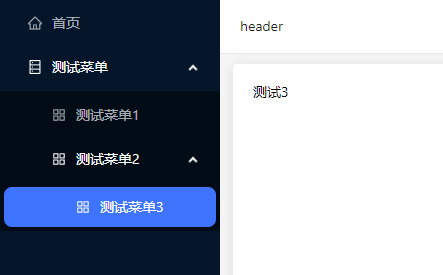
因此我们应该用pathname字段来判断高亮的是哪个菜单。
假设当前的pathname为'/test/test2/test3',那么需要被展开的菜单应该是 '/test','/test/test2',
/**
* @description 获取需要展开的subMenu
* @param {String} path 当前访问地址
* @return array
*/
export const getOpenKeys = (path:string) => {
let arr = path.split("/")
let openArr = []
let openString = ''
for(let i = 0; i < arr.length - 1; i++) {
if(arr[i]){
openString += `/${arr[i]}`
openArr.push(openString)
}
}
return openArr
}
2
3
4
5
6
7
8
9
10
11
12
13
14
15
16
17
# 展开收起侧边栏
展开收起侧边栏原理是将isCollapse存入store中,然后监听window的resize事件,当屏幕宽度小于1200时,收起侧边栏,屏幕宽度大于1200时,展开侧边栏。 我们来改造一下layouts/index.tsx
import { Layout } from "antd"
import { Outlet } from "react-router-dom"
import LayoutMenu from "./components/Menu"
import LayoutHeader from "./components/Header"
import LayoutFooter from "./components/Footer"
import "./index.less"
import { useDispatch, useSelector } from "react-redux"
import { State } from "@/types/redux"
import { useEffect } from "react"
import { updateCollapse } from "@/redux/modules/menu"
const LayoutIndex = () => {
const dispatch = useDispatch()
const {Sider, Content} = Layout
const {isCollapse} = useSelector((state:State) => state.menu)
// 监听窗口大小变化
const listeningWindow = () => {
let screenWidth = document.body.clientWidth;
if(!isCollapse && screenWidth < 1200) {
dispatch(updateCollapse(true))
}
if(isCollapse && screenWidth > 1200) {
dispatch(updateCollapse(false))
}
}
useEffect(() => {
window.addEventListener('resize', listeningWindow)
// 清除副作用
return () => {
window.removeEventListener('resize', listeningWindow)
}
},[isCollapse])
return (
<section className="container">
<Sider trigger={null} collapsed={isCollapse} width={220} theme="dark">
<LayoutMenu></LayoutMenu>
</Sider>
<Layout>
<LayoutHeader></LayoutHeader>
<Content>
<div className="content">
<Outlet />
</div>
</Content>
<LayoutFooter />
</Layout>
</section>
)
}
export default LayoutIndex
2
3
4
5
6
7
8
9
10
11
12
13
14
15
16
17
18
19
20
21
22
23
24
25
26
27
28
29
30
31
32
33
34
35
36
37
38
39
40
41
42
43
44
45
46
47
48
49
50
51
52
53
54
# header
# 面包屑导航
一般的网站都有个面包屑导航,我们使用存在redux中的menuData递归找到所有的path,并使用递归,给每个path找到对应的面包屑的数据。
/**
* @description 递归当前路由的所有关联路由,生成面包屑导航
* @param {String} path 当前访问地址
* @param {Array} menuList 菜单列表
* @return array
*/
export const getBreadcrumbList = (path: string, menuList: MenuOptions[]) => {
let tempPath: MenuOptions[] = []
try {
const getNodePath = (node: MenuOptions) => {
tempPath.push(node);
// 找到符合条件的节点,通过throw终止掉递归
if (node.path === path) {
throw new Error("GOT IT!");
}
if (node.children && node.children.length > 0) {
for (let i = 0; i < node.children.length; i++) {
getNodePath(node.children[i]);
}
// 当前节点的子节点遍历完依旧没找到,则删除路径中的该节点
tempPath.pop();
} else {
// 找到叶子节点时,删除路径当中的该叶子节点
tempPath.pop();
}
};
for (let i = 0; i < menuList.length; i++) {
getNodePath(menuList[i]);
}
} catch (e) {
return tempPath.map(item => item.title);
}
}
/**
* @description 双重递归 找出所有 面包屑 生成对象存到 redux 中,就不用每次都去递归查找了
* @param {String} menuList 当前菜单列表
* @return object
*/
export const findAllBreadcrumb = (menuList:MenuOptions[]) : {[key: string]:string[]|undefined} => {
let handleBreadcrumbList: {[key: string]:string[]|undefined} = {}
const loop = (menuItem: MenuOptions) => {
if(menuItem?.children?.length) {
menuItem.children.forEach(item => loop(item))
}else{
handleBreadcrumbList[menuItem.path] = getBreadcrumbList(menuItem.path, menuList)
}
}
menuList.forEach(item => loop(item))
return handleBreadcrumbList
}
2
3
4
5
6
7
8
9
10
11
12
13
14
15
16
17
18
19
20
21
22
23
24
25
26
27
28
29
30
31
32
33
34
35
36
37
38
39
40
41
42
43
44
45
46
47
48
49
50
51
可能这样比较难理解,我们看一下得到的handleBreadcrumbList是什么,就清楚我在做什么了。

只需要用页面useLocation钩子中的pathname作为键就能快速得到面包屑导航的数据了。
# 个人信息窗口弹出,以及如何暴露方法给父组件
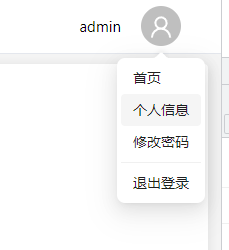
这是写好的个人信息下拉菜单,现在希望点击个人信息的时候能弹出个人信息的窗口来,我希望个人信息组件能够向外暴露出一个打开窗口的方法。
react中其实有解决办法:
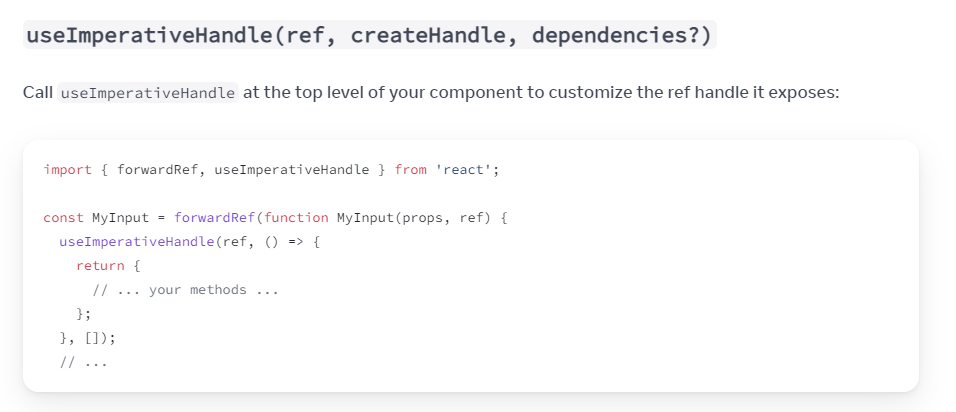
参考上图,使用useImperativeHandle Hooks,封装一个个人信息组件:
import { Modal } from "antd"
import { useImperativeHandle, useState, forwardRef, Ref, ForwardedRef } from "react"
export interface InfoRef {
showModal():void
}
const InfoModal = (props:{},ref:ForwardedRef<InfoRef>) => {
const [modalVisible, setModalVisible] = useState(false)
const showModal = () => {
setModalVisible(true)
}
useImperativeHandle(
ref,
() => ({
showModal() {
showModal()
}
}),
[]
);
const handleOk = () => {
setModalVisible(false)
}
const handleCancel = () => {
setModalVisible(false)
}
return (
<Modal
title="个人信息"
open={modalVisible}
onOk={handleOk}
onCancel={handleCancel}
destroyOnClose={true}
>
<p>个人信息:不过暂时没有咯</p>
<p>你们就随便看看就行了</p>
<p>好了别看了,知道我长得帅了</p>
</Modal>
)
}
export default forwardRef(InfoModal)
2
3
4
5
6
7
8
9
10
11
12
13
14
15
16
17
18
19
20
21
22
23
24
25
26
27
28
29
30
31
32
33
34
35
36
37
38
39
40
41
42
43
44
45
46
47
48
49
然后在父组件中使用ref就可以获取到InfoModal:
const infoRef = useRef<InfoRef>(null)
// 调用 infoRef.current?.showModal()就可以打开弹窗
// infoRef.current?.showModal()
<InfoModal ref={infoRef} />
2
3
4
5
6
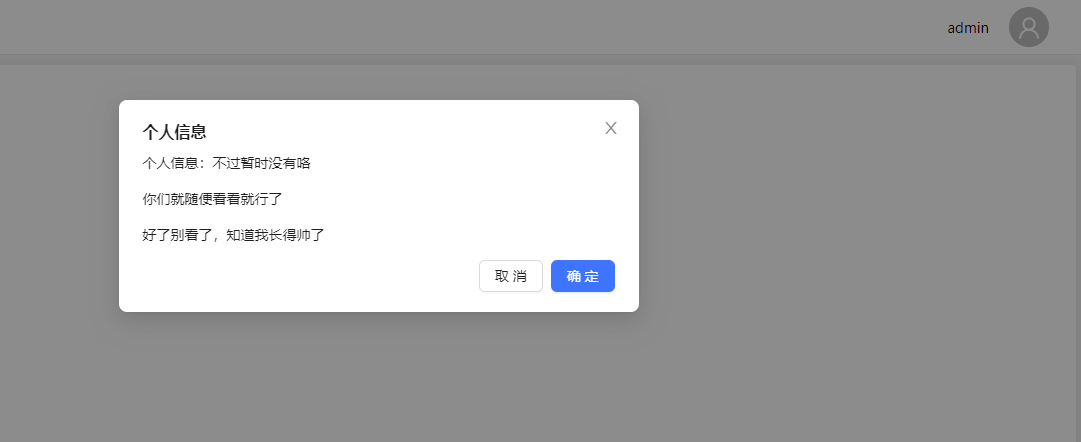
打开成功啦
# tabs
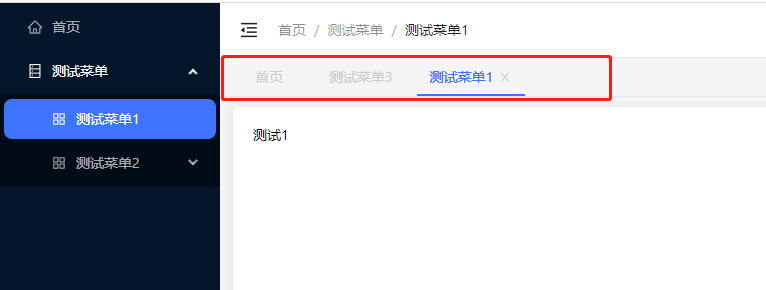
简单说一下这个tab菜单的原理吧:
- 使用useLocation获取到pathname
- 用useEffect监听pathname,打开了新页面就往tabs列表里加一项
import { useDispatch, useSelector } from "react-redux"
import { setTabsList } from "@/redux/modules/tabs"
import { useLocation, useNavigate } from "react-router-dom"
import { searchRoute } from "@/utils/menu"
import React, { useEffect, useState } from "react"
import { Tabs } from "antd"
import { HOME_URL } from "@/utils/config"
import "./index.less"
import { State } from "@/types/redux"
import { MenuOptions } from "@/types/menu"
const LayoutTabs = () => {
const dispatch = useDispatch()
const { tabsList } = useSelector((state:State) => state.tabs)
const { menuData } = useSelector((state:State) => state.menu)
const { pathname } = useLocation()
const navigate = useNavigate()
const [activeValue, setActiveValue] = useState(pathname)
useEffect(() => {
addTabs()
}, [pathname])
const addTabs = () => {
const route = searchRoute(pathname, menuData)
let newTabsList = JSON.parse(JSON.stringify(tabsList))
if(tabsList.every((item:MenuOptions) => item.path !== route.path) && (route.path !== HOME_URL)) {
newTabsList.push({title: route?.title, path: route.path})
}
dispatch(setTabsList(newTabsList))
setActiveValue(pathname)
}
const delTabs = (path: React.MouseEvent | React.KeyboardEvent | string) => {
if(pathname === path) {
let index = tabsList.findIndex((item:MenuOptions) => item.path === path)
if(tabsList.length > 1) {
if(tabsList[index + 1]) {
navigate(tabsList[index + 1].path)
}else{
navigate(tabsList[index - 1].path)
}
}else{
navigate(HOME_URL)
}
}
dispatch(setTabsList(tabsList.filter((item:MenuOptions) => item.path !== path)))
}
const clickTabs = (path:string) => {
navigate(path)
}
return (
<div className="tabs">
<Tabs
activeKey={activeValue}
onChange={clickTabs}
hideAdd
type="editable-card"
onEdit={delTabs}
items={
[
{
label:'首页',
key:HOME_URL,
closable: false
},
...tabsList.map((item:MenuOptions) => {
return {
label: item.title,
key: item.path
}
})
]
}/>
</div>
)
}
export default LayoutTabs
2
3
4
5
6
7
8
9
10
11
12
13
14
15
16
17
18
19
20
21
22
23
24
25
26
27
28
29
30
31
32
33
34
35
36
37
38
39
40
41
42
43
44
45
46
47
48
49
50
51
52
53
54
55
56
57
58
59
60
61
62
63
64
65
66
67
68
69
70
71
72
73
74
75
76
77
78
79
80
81
